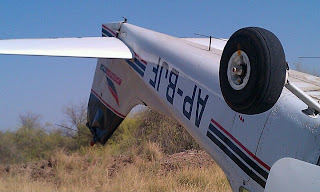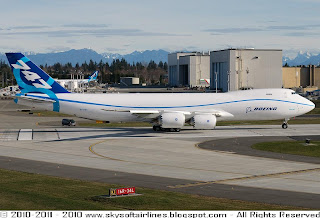The Private Pilot Licence (PPL) CourseSyllabus:
Theory - 100 hours of ground school
Flight - 40 hours of flight training
course consists of a minimum 45 hours of ground training and a minimum of 40 hours of flight training on Cessna172 Aircraft . An average student takes about 45 to 50 hours of flight training. Out of the required minimum of 40 hours, the student must have completed at least:
25 hours of dual training
10 hours of solo including 5 hours of navigation
3 hours of dual night flying
2 hours of dual simulated instrument flying training.
Written Test
You must pass a knowledge test with a score of 70% or better. This test is administered at CAA facility. the test consists of 75 multiple-choice questions selected from the Private Pilot Test Bank.
Flight Test
You must successfully complete a practical test, which will be given as a final exam by CAA inspector or a designated examiner. The CAA designated examiners are professionals , experienced flight instructors who are authorized by the CAA to conduct flight tests..
Requirements:
1. High school or equivalent as a minimum education must pass Physics,Mathematics and English.
2. Good command of the English language
3. Minimum age 18 years to enrol for the course and 19 years to obtain a licence
4. Class II Medical certificate by a CAA physician
5. All students required by law to get Security clearance prior to commencing flight training in the Schon Air Flying Academy will apply for your security clearance when all your documents with course application fee received.
6. Personal interview with the Schon Air Flying Academy enrolment committee
Duration:
Approximately 5 - 6 months
Courses:AIRLAW AND ATC PROCEDURES
OPERATIONAL PROCEDURES
METROLOGY
PRINCIPLE OF FLIGHTS
AERODYNAMIC
SYSTEM AND POWER PLANT
INSTRUMENTATION
VFR AND IFR
COMMUNICATION
FLIGHT PLANING
MASS AND BALANCE
NAVIGATION RADIO NAVIGATION
Instrument Rating The Instrument Rating gives the ability to control the aircraft without reference to the ground , using flight and navigation instruments. This is required of the professional pilot who must be able to demonstrate proficiency in instrument flying regardless of the type of aircraft they fly. Instrument training is among the most challenging and satisfying parts of the program.
Syllabus:
Theory - 100 hours of ground school
Flight - 40 hours of flight training
course consists of a minimum 45 hours of ground training and a minimum of 40 hours of flight training. An average student takes about 45 to 50 hours of flight training. Out of the required minimum of 40 hours, the student must have completed at least:
40 hours flight training under a hood or actual instrument meteorological conditions.
100 hours of ground school
Written Test
You must pass a knowledge test with a score of 70% or better. This test is administered at CAA facility. the test consists of 75 multiple-choice questions.
Flight Test
You must successfully complete a practical test, which will be given as a final exam by a CAA inspector or a designated examiner. The CAA designated examiners are professionals, experienced flight instructors who are authorized by the CAA to conduct flight tests. There is a fee for the flight
Requirements:
1. Valid CAA PPL Licence
2. Good command of the English language
3. Class II Medical certificate by a UAE GCAA physician
4. All student required by law to get security clearance prior to commencing flight training in the Pakistan (Schon Air will apply for your security clearance when all your documents with course application fee received).
5. Personal interview with the Schon Air Flying Academy enrolment committee
Duration:
Approximately 4 - 6 months
Courses
AIRLAW AND ATC PROCEDURES
OPERATIONAL PROCEDURES
METROLOGY PRINCIPLE OF FLIGHTS
AERODYNAMIC
SYSTEM AND POWER PLANT
INSTRUMENTATION
VFR AND IFR COMMUNICATION
FLIGHT PLANING
MASS AND BALANCE
NAVIGATION RADIO NAVIGATION
Comercial Pilot LiscenceSyllabus
• CAA Private Pilot License (PPL)
- 40 Hours Cessna 172 Aircraft
- 45 Hours Ground Instruction
• Hour Building Phase
- 95 Hours Cessna 172 Aircraft
• Instrument Rating (IR)
- 40 Hours C-172
- 45 Hours Ground Instruction
• Commercial Multi-Engine License (CPLME)
-25 hours
- 100 Hours Ground Instruction
course consists of a minimum 190 hours of ground training and a minimum of 190 hours Single Engine Flight Trainig and 10 hours Multi Engine flight Training, 200 hours minimum at end of CPL course, to obtain CAA CPL, after successful completion of a flight check.
Written Test
You must pass three knowledge tests with a score of 70% or better (PPL, IR, and CPL). This test is administered at CAA facility. The test consists of 75 multiple-choice questions.
Flight Test
You must successfully complete a three practical tests (PPL, IR, and CPL), which will be given as a final exam by a CAA inspector or a designated examiner. The CAA designated examiners are professionals, experienced flight instructors who are authorized by the CAA to conduct flight tests.
Requirements:
1. High school or equivalent as a minimum education
2. Good command of the English language
3. Minimum age 18 year to enrol for the course and 19 years to obtain a licence
4. Class I Medical certificate by a CAA physician
5. All student required by law to get security clearance prior to commencing flight training in the Pakistan (Schon Air will apply for your security clearance when all your documents with course application fee received .)
6. Personal interview with the S enrolment committee
Duration:
Approximately 18 months
Multi-Engine RatingThe Multi-Engine Rating allows you to fly what most people consider to be a "real" airplane - with more performance and more than one engine. This course is designed to take a holder of an CAA Private or Commercial Pilot's License who meets the aeronautical experience requirements to a certified multi-engine rating.
Syllabus:
Theory - 20 hours of ground school
Flight - 15 hours Multi Engine.
course consists of a minimum 20 hours of ground training and a minimum of 15 hours Multi Engine Flight Training on Piper or C-402 Aircraft.
Written Test
You must pass a knowledge test with a score of 70% or better. This test is administered at CAA facility. the test consists of 75 multiple-choice questions.
Flight Test
You must successfully complete a practical test, which will be given as a final exam by an CAA inspector or a designated examiner. The CAA designated examiners are professionals, experienced flight instructors who are authorized by the CAA to conduct flight tests.
Requirements:
1. A valid CAA Private Pilot or Commercial Pilot (if foreign PPL or CPL, will need to convert to CAA license)
2. High school or equivalent as a minimum education
3. Good command of the English language
4. Class I Medical certificate by a CAA physician
5. All student required by law to get security clearance prior to commencing flight training in the Pakistan (Schon Air will apply for your security clearance when all your documents with course application fee received.)
6. Personal interview with the Schon Air Flying Academy enrolment committee
Duration:
Approximately 1.5 months
Flight Instructor rating The Flight Instructor. A position for students who desire to accumulate experience to qualify for the Airline Transport Pilot certificate (ATP). The Certified Flight Instructor (CFI) must demonstrate excellent flying skills, thorough knowledge of the academic subjects, and be able to communicate effectively.
Syllabus:
Theory - 85 hours of ground school
Flight - 30 hours of flight training
Written Test
You must pass a knowledge test with a score of 70% or better. This test is administered at CAA facility. the test consists of 75 multiple-choice questions.
Flight Test
You must successfully complete a practical test, which will be given as a final exam by an CAA inspector or a designated examiner. The CAA designated examiners are professionals, experienced flight instructors who are authorized by the CAA to conduct flight tests.
Requirements:
1. Valid CAA Commercial Pilot Licence / Instrument Rating
2. Class I Medical certificate by a CAA physician
3. All student required by law to get Security clearance prior to commencing flight training in the Pakistan (Schon Air will apply for your security clearance when all your documents with course application fee received .)
4. Personal interview with the Schon Air Flying Academy enrollment committee
Duration:
Approximately 4 - 6 months
Licencse Conversion
Schon Air conversion courses to the CAA type licences. We aim to provide the most up to date information, but please check with the appropriate regulatory authority for the latest and most current regulations for your conversion. In order to convert to any CAA License you must meet the experience as per CAR part II for the issue of the licence you are applying for, and you must complete the following:
1. Flight and ground training as required to prepare you for air law knowledge test with a score of 70% or better. This test is administered at CAA facility and you must successfully complete oral and a practical test, which will be given as a final exam by an CAA inspector or a designated examiner
a. Theory - 4 hours of ground school
b. Flight - 10 hours of flight training for PPL and 8 hours of flight training plus 4 hours FNPT II for CPL/ATPL
2. Valid foreign Medical Certificate and Licence.
3. Minimum 18 years of age for a CPL and 21 years for an ATPL .
4. Meet the experience requirement for the issuance of PPL/CPL/ATPL.
5. Letter from approved school / operator.
6. All student required by law to get Security clearance prior to commencing flight training in the Pakistan (Schon Air will apply for your security clearance when all your documents with course application fee received .)
7. Personal interview with the Schon Air Flying Academy enrollment committee and he/she must demonstrate excellent flying skills, thorough knowledge of the academic subjects
Upon completion of the above steps you will be issued with a CAA Pilots Licence.
Duration:
Approximately 1 month





























































